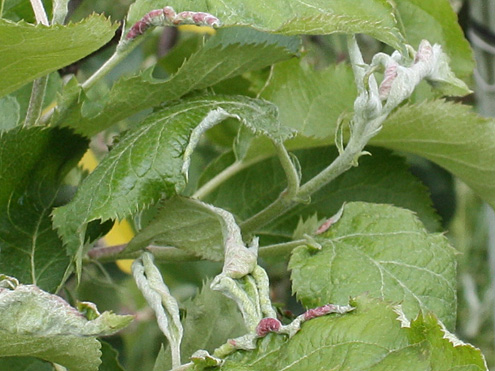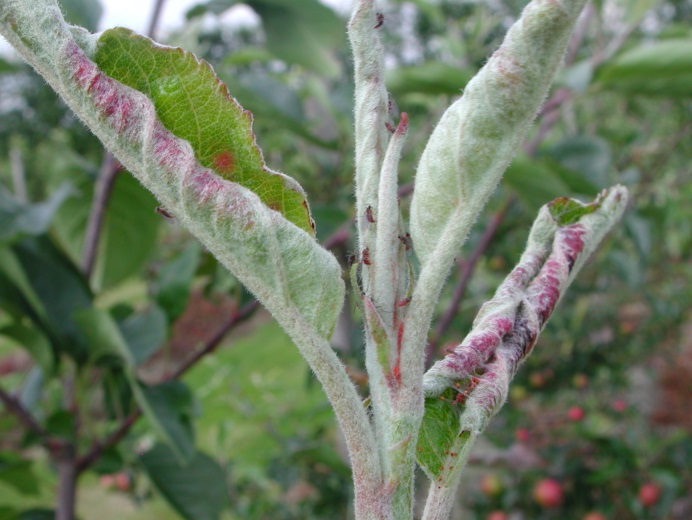
Apple leaf curling midge
| Primefact number | Edition | Published | Author |
|---|---|---|---|
| 1158 | Second | Apr 2017 | Plant Biosecurity and Product Integrity |


Apple leaf curling midge (Dasineura mali) is an exotic plant pest not present in Australia. This pest is a serious threat to Australia’s apple industry.
Notifiable status
Apple leaf curling midge (Dasineura mali) is a notifiable plant pest in NSW.
All notifiable plant pests and diseases must be reported within 1 working day. You can report notifiable plant pests and diseases by one of the following methods:
- Call the Exotic Plant Pest Hotline 1800 084 881
- Email biosecurity@dpi.nsw.gov.au with a clear photo and your contact details
- Complete an online form
A full list of notifiable plant pests and diseases can be found in Schedule 2 of the NSW Biosecurity Act 2015.
Symptoms
Symptoms of damage caused by apple leaf curling midge are distorted, rolled and discoloured leaves (Figure 1). Rolled leaf edges prevent young leaves from unfolding and the roll becomes tighter as leaf growth continues.
Damage is caused by the larval stage of the insect. Apple leaf curling midge maggots feeding on apple leaves make them curl tightly upwards and the leaf edges are rolled together into distorted tubes (Figure 2). Leaf tissues thicken and become brittle. Leaves turn red brown.
Damage can be confused with aphid infestations.
Description
The adult apple leaf curling midge is a small fly. The insect has four life stages: eggs, larvae, pupae and adult.
Adults
Adult flies have a dark brown body, about 1.5-3 mm long and resemble a mosquito.
Female apple leaf curling midges produce a sex pheromone to assist males to find them for mating.
The number of generations per year is related to temperature.
Eggs
Leaves are the preferred site for egg laying. Eggs are laid irregularly in groups on the margin or upper side of unfolding leaves.
In early spring prior to leaf emergence eggs are laid on the bracts of leaf buds and in developing flowers.
Eggs are transparent pink to pale red in colour and cigar-shaped. They take from 2-10 days to hatch depending on temperature conditions.
Larvae
Larvae (maggots) are initially white but become a bright orange-red colour at the final instar.
Immature larvae spend most of their life within a rolled leaf. They die if exposed to bright sunshine.
Larvae take 20 days to reach maturity.
Mature larvae exit the leaf roll and fall to the ground to pupate. Prolonged dry conditions may prevent or delay mature larvae from exiting leaf rolls. Thorough wetting of the leaves assists the larvae to escape to find pupation sites.
Pupae
Pupation takes place just below the soil surface in a tough white silken cocoon.
Pre-pupae have the same orange colour as mature larvae and are clearly visible inside the cocoon. Mature pupae are brown.
During warmer months pupation takes 8-13 days.
Apple leaf curling midge can survive cold winters by remaining as pupae inside the cocoon until favourable conditions return.
Host
Apple trees (Malus spp.) are the only host of the apple leaf curling midge.
The severity of apple leaf curling midge infestations can differ between apple cultivars, although the susceptibility can vary through the season depending on the availability of shoots suitable for egg laying.
No apple cultivar is known to be resistant to infestation if the pest is present.
Damage
Feeding larvae of apple leaf curling midge can affect apple leaves, flowers and fruit.
Flower and fruit damage occurs when high populations of apple leaf curling midge are present during flowering. Eggs laid on flowers can affect the developing fruitlets resulting in distorted bumpy fruit.
Terminal shoots may be stunted and growth of grafted scions may be retarded or killed.
Larvae feeding on leaves prevents the leaves from fully expanding. Leaves may drop prematurely. Leaf and shoot damage affects crop yield.
World distribution
Apple leaf curling midge is of European origin and has spread to North America and New Zealand.
International experience
Apple leaf curling midge was accidently introduced into New Zealand in 1950. By the mid 1980’s apple leaf curling midge populations and damage had greatly increased.
Soil treatments can be used to reduce adult emergence.
Insecticide control of the larval stage is difficult because larvae are protected inside the rolled leaves.
Actions to minimise risks
Put in place biosecurity best practice actions to prevent entry, establishment and spread of pests and disease:
- practice “Come clean, Go clean”
- ensure all staff and visitors are instructed in and adhere to your business management hygiene requirements
- source propagation material of a known high health status from reputable suppliers
- keep records

